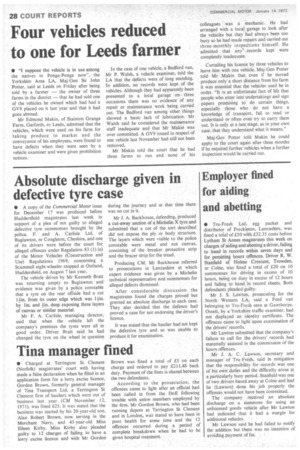Absolute discharge given in defective tyre case
Page 30

If you've noticed an error in this article please click here to report it so we can fix it.
• A copy of the Commercial Motor issue for December 17 was produced before Huddersfield magistrates last week in support of a plea of not guilty to alleged defective tyre summonses brought by the police. F. and A. Carlisle Ltd, of Buglawton, nr Congleton, Cheshire, and one of its drivers were before the court for alleged offences under Regulation 83 (1) (e) of the Motor Vehicles (Construction and Use) Regulations 1969, concerning a Scammell eight-wheeler stopped at Outland, Huddersfield, on August 7 last year.
The vehicle driven by Mr Kenneth Bratt was returning empty to Buglawton and evidence was given by a police constable that a tyre on the rear offside had a cut lfin. from its outer edge which was I fin. by lin. and fin, deep exposing three layers of canvas or similar material.
Mr F. A. Carlisle, managing director, said that when the vehicle left the company's premises the tyres were all in good order. Driver Bratt said he had changed the tyre on the wheel in question during the journey and at that time there was no cut in it.
Mr J. A. Backhouse, defending, produced a cut-away section of a Michelin X tyre and submitted that a cut of the sort described did not expose the ply or body structure. The layers which were visible to the police constable were metal and not canvas, consisting of the breaker protective strip and the bracer strip for the tread.
Producing CM, Mr Backhouse referred to prosecutions in LanCashire at which expert evidence was given by a Michelin technical representative and summonses for alleged defects dismissed.
After considerable discussion the magistrates found the charges proved but granted an absolute discharge in each case. They also decided that the defence had proved a case for not endorsing the driver's licence.
It was stated that the haulier had not kept the defective tyre and so was unable to produce it for examination.
















































































































